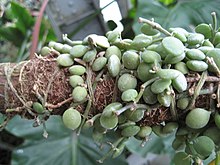Phloeophila is a genus of orchids belonging to the tribe Pleurothallidinae. While an initial molecular phylogeny in 2013 suggested that the type species of the genus was nested within Pabstiella, further sampling showed that it in fact belongs to a unique clade distant from Pabstiella, forming the current basis of the genus.
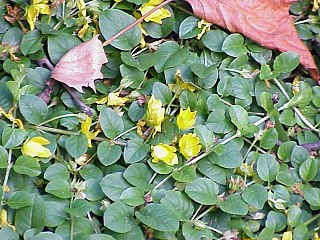
Lysimachia nummularia is a species of flowering plant in the primrose family Primulaceae. Its common names include moneywort, creeping jenny, herb twopence and twopenny grass.
Dischidia is a genus of plants in the “dog-bane” family Apocynaceae, collectively known as the “milkweeds”. They are epiphytes, native to tropical areas of China, India as well as Bhutan’s southern borders, wherever minimal frost occurs. Additionally, they are known from most areas of Mainland Southeast Asia, including forested areas of Myanmar, Thailand, Vietnam, Cambodia, Laos, and some parts of Indonesia, Malaysia and Singapore. Several species are also native to Papua New Guinea and northeastern Australia.
Taverniera is a genus of legume in the family Fabaceae. It includes 17 species of shrubs or shrublets which range from Egypt eastwards to the Arabian Peninsula, Iraq, Iran, Pakistan, and India, and southwards to Ethiopia and Somalia. Typical habitats include seasonally-dry tropical and subtropical desert, shrubland, and bushland.

Arctostaphylos nummularia subsp. mendocinoensis, commonly known as pygmy manzanita, is a subspecies of manzanita. It is endemic to Mendocino County, California, where it is known from scattered occurrences in the pygmy forests near the coast.
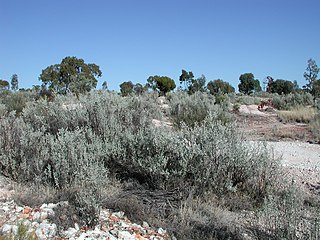
Atriplex nummularia is a species of saltbush from the family Amaranthaceae and is a large woody shrub known commonly as oldman saltbush. A. nummularia is native to Australia and occurs in each of the mainland states, thriving in arid and semi-arid inland regions.
Grazielia is a genus of South American flowering plants in the family Asteraceae.
Dorstenia nummularia is a plant species in the family Moraceae which is native to Cuba.
Myrteola is a plant genus in the Myrtaceae described as a genus in 1856. It is native to South America and the Falkland Islands.

Dischidia major, the Malayan urn vine, is a plant in the genus Dischidia. They carry modified leaves, offering accommodation to ants, including those of the family Dolichoderinae, and in return gain some sustenance from increased carbon dioxide and nitrogen levels, and a degree of protection from noxious animals and plants. This mutualism trait, known as myrmecophily, is widespread across the plant world and clearly carries considerable benefits for both ants and plant.
Dischidia tonkinensis is an epiphytic plant in the genus Dischidia. It is distributed mainly in the south China provinces of Yunnan, Guangxi, and Guizhou, at altitudes of 300 to 1,200 m above sea level. It normally grows in mountain forests and on rocks. Dischidia esquirolii is a synonym. It has not been cultivated.
Catanthera is a genus of flowering plants belonging to the family Melastomataceae.
Marcetia is a genus of flowering plants belonging to the family Melastomataceae.
Pachycaulos is a genus of flowering plants belonging to the family Gesneriaceae. It has two species, Pachycaulos nummularia and Pachycaulos huancabambae. Its native range is Southeastern Mexico to Peru.
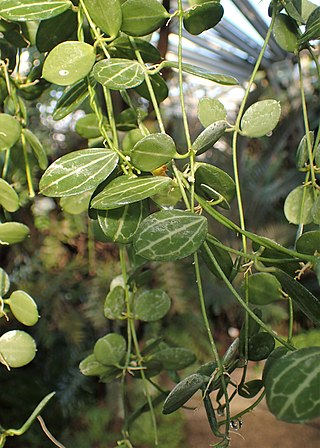
Dischidia ovata, commonly called watermelon dischidia, is a small vine in the frangipani and hoya family Apocynaceae, native to New Guinea and Cape York Peninsula, Australia. The species name ovata refers to its ovate leaves, its common name refers to the leaf venation that resembles a watermelon rind. The species is succulent and grows as an epiphytic or lithophytic vine in a variety of habitats.

Dischidia vidalii, commonly known as an "ant plant" or "kangaroo pouch", is a plant in the genus Dischidia native to the Philippines. D. vidalii is an epiphytic climbing plant with clusters of pink or magenta flowers. Like some others in its genus like Dischidia major and in the related genus Hoya, this species has evolved a symbiotic relationship with ants. In addition to small, oval leaves the plant develops significantly larger, hollow leaves where additional roots grow and there is habitat for ants where water and debris collect that nourish the roots.

Dischidia imbricata is a plant in the genus Dischidia native to Southeast Asia from Vietnam to Borneo and Java. Like Hoya imbricata, Dischidia imbricata is a shingling plant that, as it grows epiphytically, clings closely to the host plant and may even have leaves that are completely flat like roof shingles.

Dischidia platyphylla is a species of plant in the genus Dischidia native to the Philippines. Its name (platyphylla) refers to the flattened leaves, which as it climbs may cling in a shingle-like way to trees, similar to related species like Dischidia imbricata. These leaves are a form of domatia, which act as a shelter for ants in an example of mutualism with ants that is found in several species of Dischidia.
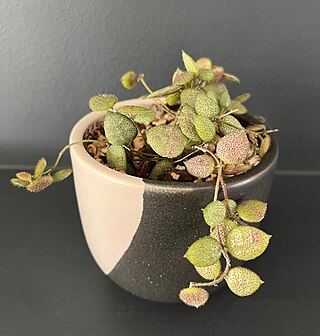
Dischidia hirsuta is a species of plant in the genus Dischidia. It is widely distributed in Southeast Asia from Thailand through Vietnam, Indonesia, the Philippines and continuing to the Solomon Islands. It grows as an epiphyte and its name refers to its often hirsute foliage covered in fine hairs, though the species has variable foliage and flowers throughout its range. Its succulent leaves may be lanceolate to more rounded, and are sometimes covered with red spots. The flowers range from pale yellow to dark red.

Dischidia astephana is a species of plant in the genus Dischidia native to Peninsular Malaysia and Borneo. A vining epiphyte that can cover an entire tree branch in dense leaves, it is often found growing near other Dischidia including D. albida,D. parvifolia, and D. vadosa. Its leaves are shaped like flat rings or domes, some of which will be tightly appressed to the surface of the tree where it grows. It lives symbiotically with ants of the Crematogaster genus on trees, with the roots growing inside ant nests and using debris for nutrients.
